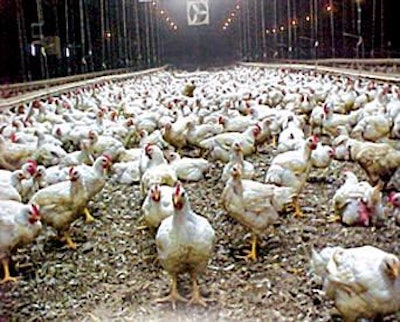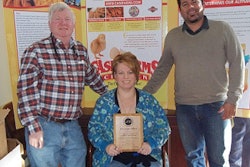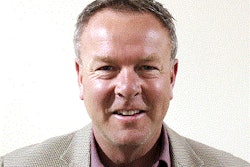
Biosecurity dictates that there is usually a geographic separation between the poultry farm and the poultry processing plant. This distance confers the benefits of isolation, but it can come with drawbacks from an operational and management point of view.
In many cases, poultry farms are managed by veterinary professionals, or other suitably qualified persons, with an exclusive on-farm focus designed to produce as many kilos of meat per square meter as possible.
Focus too narrow?
Poultry farm managers have a lot to consider. To obtain the most from birds, they need to consider the state of the facilities, water, feed quality, chick quality and biosecurity and all of this within the chicken's short lifespan. Because of this, it is not unusual to see the poultry farm manager interacting on a daily basis with staff and others concerned in these aspects of the business, as any deviation from optimal levels can cause meat loss or increased input costs.
Another characteristic of broiler production that can reduce interaction with partners is that personnel are required to remain on site. This may help to foster a group dynamic within the poultry farm team, but it also encourages a sense of independence and separation from other divisions of the business.
Attitudes have changed somewhat over recent years, but any visit to a major poultry production trade event will reveal that the primary focus remains on poultry production, hatching, and feed - not on processing.
These various circumstances reinforce the thinking of the farm manager that production per square meter of farm floor space is his/her goal, and this unconscious barrier to working with the processing plant can reach, at times, the height of the Great Wall of China!
Yet, in the majority of cases, most money is made from selling processed chickens and not from selling live ones!
Processing staff needs wider view
These issues, however, are not only present on the poultry farm. The poultry processing plant has a very similar set of issues.
When new members of a plant's administration join the business, they may be shown around the plant's facilities and told how they will fit into the company's structure, but rarely are they told where the plant's raw materials - the birds - come from or how they are produced.
This approach further strengthens the idea of two completely separate business units, when the poultry farm and the poultry processing plant really ought to be working together closely.
On those occasions the farm staff does visit the processing plant, they are viewed as outsiders and not as part of the team. A lack of understanding of what they do makes communication even more difficult.
Another issue that can run across both sites is the problem of attitude. This can be summed up as the difference between "having to learn" and "wanting to learn". It should be remembered that any barrier to learning is purely psychological and is related to the culture in which we work. A change in attitudes is not the result of external pressure, but one of internal change on the part of the individual.
Equal treatment
The physical distance between farm and plant and the daily duties of the workers at each site can be seen as further obstacles to learning about what goes on at the partner site. Missing staff could lead to the detriment of the operation of the site itself. But does this have to be viewed quite so negatively?
When it comes to the administrative and management functions, things happen that demand immediate attention, and the staff at this level is allowed to leave the facility. The staff's absence also could have an impact on the running of its particular section and could impact product quality and profitability.
Possible routes forward
There are various ways that the poultry farm and the poultry plant - and their respective employees - can become more integrated.
Teamwork, it should be remembered, is the bringing together of effort to reach a common goal. Good teams are like families - they look after each other.
From the farm
Taking the position of the broiler producer, the following approaches could be adopted:
- The induction of new staff needs to be as comprehensive as possible. Regardless of the function of the new employee, it must be emphasized that the goal of the business is to bring as much Grade A chicken to market as possible. With this in mind, each and every function and process that influences the final goal must be examined from reproduction to cold room storage.
- All new staff must understand how their actions and decisions impact the subsequent production processes. For example, if birds arrive with a full crop, incomplete feed withdrawal could cause the crop to rupture during processing, leading to carcasses becoming contaminated.
- In addition to weekly divisional meetings, there should be special meetings between the farm team and the processing team to look at the results obtained in the processing plant. This particularly should focus on dead on arrival and may reveal trauma incurred during harvesting, transport or poorly administered feed withdrawal.
- In many processing plants, there is an agreement in place that a representative from the chicken producer should always be at the processing plant during the processing of that supplier's birds. The reason for this is to ensure that processing is compliant with legislation in force, and checks are carried out from beginning to end of the process. This person should be an employee of the farm and not the plant and should participate in relevant meetings so that any problems can be brought into the open and resolved as quickly as possible.
From the processing plant
During the capture and transport of birds, a representative of the processing company should be present to ensure that everything is as it should be.
Checks may include examining whether cages have been washed and disinfected, have properly functioning lids and are not broken and that birds are not harmed during transport.
Staff seminars - with participants from both the farm and the processor - could be carried out a set number of times each year. Representatives from both sides can share common experiences, allowing not only the exchange of information but also the development of possible solutions to any problems that may have arisen.
The number of attendees will depend on the size of the businesses, and the attendees could be extended to include representatives from incubation and hatching companies. While at first glance this latter suggestion may seem a little unnecessary, it should be remembered that the overall goal is to produce as much Grade A chicken as possible, and so all participants in the process need to be included.
All of this extra consideration and attention to detail could be encouraged through an attractive monthly bonus scheme shared equally among all contributors.

















